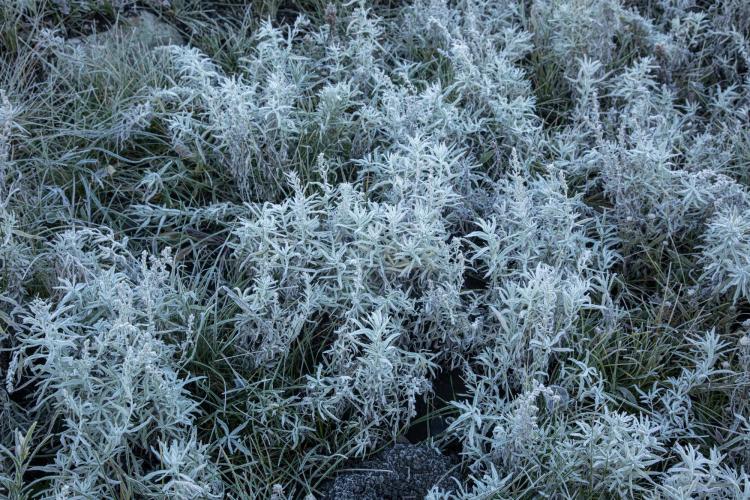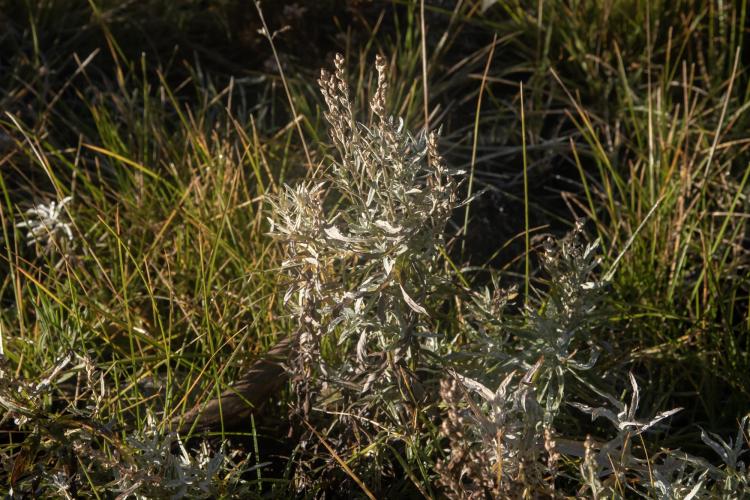Sagebrush has an arsenal of defenses for an army of herbivores
That potent aroma prized by humans serves many functions for the plant
The Elk Mountains displayed bright colors on a frosty morning in early October. The sky was blue, the air was clear, and aspen displayed their full range of fall foliage colors. The rising sun's light crept across a meadow, revealing plants whose leaves were gilded silver in frost but fading to silvery green when frost yielded to sunlight.
The meadow plants reminded me of big sagebrush, but these silvery plants were much smaller.
Inquiries placed with David Inouye and Rick Williams at the nearby Rocky Mountain Biology Lab in Gothic identified this species as silver sagebrush, Artemisia ludoviciana. It is widespread in North America, occurring in most of Canada and most of the contiguous 48 states.

Frost sparkles on the soft leaves and stems of silver sagebrush.
Surveys of nearly 500 Artemisia species indicate that they are widespread in the Northern Hemisphere, and they can be grouped into three growth forms: herbaceous perennials, suffrutescents and shrubs. A. ludoviciana is an herbaceous perennial, meaning it has no wood but sprouts each year from rhizomatous roots.
Suffrutescents have a minimal amount of wood at their bases. Shrubs are smaller than trees and have multiple woody stems. The familiar big sagebrush, A. tridentata, is a shrub that dominates many plant communities in the west.
Many vertebrate herbivores utilize sagebrush species. In North America, the greater sage-grouse, Centrocercus urophasianus, gains weight in winter by eating sagebrush leaves. The sage grasshopper Hypochlora alba is a specialist on the leaves of silver sagebrush (more below), and sagebrush leaves are a primary food source for pronghorn antelope and mule deer.
However, four species of rabbits, multiple species of ground squirrels, mice, packrats, prairie dogs, chipmunks, pocket gophers and kangaroo rats browse on sagebrush. Herbivores provide the natural selection that drives sagebrush species to develop diverse defenses.
Glandular and non-glandular trichomes are tiny appendages on both the upper and lower surfaces of silver sagebrush leaves. Glandular trichomes are organs that contain and release plant defenses in the form of sesquiterpene lactones, which can be irritating, cytotoxic, antimicrobial and antifungal.
The solely physical trichomes consist of a long hair, pointed at both ends, balanced on a pedestal of cells—this structure suggests the letter T. These silvery trichomes are so dense that they occlude the undersides of leaves. They are less dense on the upper sides of leaves, and their density varies among individual plants. The non-glandular trichomes are a physical deterrent to small mouth parts and can block the intestines of insects.

Silver sagebrush flowers in bloom.
The sage grasshopper specializes on silver sagebrush, while most grasshoppers are deterred by the dense fuzziness of trichomes. A laboratory feeding study compared the sage grasshopper with a generalist that would not choose to feed on silver sagebrush.
Neither grasshopper, when offered a diet restricted to silver sagebrush leaves, was able to digest the hairs, but sage grasshoppers could pass them efficiently and grow optimally on their normal diet. The hairs did not poison the generalist grasshoppers, but hairs slowed absorption from the gut and movement through the gut to the point that generalists grew slowly and did not complete normal development.
When silver sagebrush is chewed by insects, it releases methyl jasmonate (hereafter MJ) from its glandular trichomes. MJ is a pheromone, a chemical signal to other silver sagebrush plants that respond by producing MJ as well.
MJ is also a defensive chemical. Big sagebrush, when incubated in plant chambers with tomato plants, release MJ, triggering the release of proteinase inhibitors that interfere with the digestion of herbivorous insects, making them sick and unable to eat.
Allelopathy is defined as a chemical interference of one plant species with competing species by releasing chemicals that inhibit growth or germination. MJ released by sagebrush acts as an allelochemical to inhibit germination of coyote tobacco, Nicotiana attenuata, a sympatric native in the Great Basin.
The level of MJ naturally exuded from big sagebrush leaves reduced the germination of coyote tobacco seeds by 60% in the soil beneath and around the big sagebrush. Allelopathy may be one of the contributing factors to the dominance of big sagebrush in sagebrush steppe, pinyon-juniper woodlands, and montane grasslands in the West.

Silver sagebrush sighted at campsite in the morning.
Artemisia species have been used by people through the ages to treat a wide variety of ailments, and their importance has not diminished. For example, a sagebrush species called sweet wormwood (A. annua) is the source of the defensive chemical artemisinin. This species is native to China and has been used for its pharmaceutically active chemicals for over 2,000 years.
In 1969, Tu Youyou was appointed to head a project to discover an effective treatment against Plasmodium falciparum, which causes malaria. She discovered artemisinin in 1972, and in 2015 shared the Nobel Prize in physiology or medicine for her work.
The next time you are in a plant community dominated by Artemisia, notice the characteristic fragrance and recall its antimicrobial, pheromonal, defensive and allelochemical functions.

